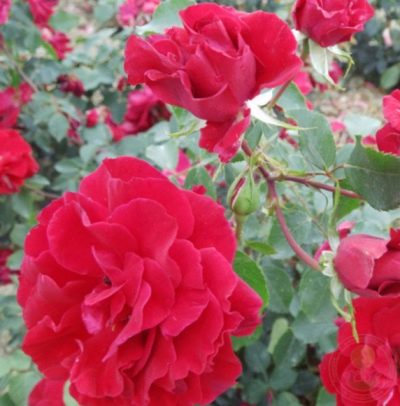
- Authors: Harkness
- Name synonyms: Baikal
- Breeding year: 2002
- Group: climbing
- The main color of the flower: red
- Flower size: large
- Diameter, cm: 9
- Flower type by number of petals: medium terry
- Scent: soft
- Description of the bush: vigorous growth, well branched
Landscape designers love to use climbing roses in their work, from which festive arches, columns are erected, hedges are made, and gazebos are decorated. A suitable variety is the Baikal rose, which came from the UK.
Breeding history
The bright and beautiful Baikal rose is a creation of English breeders, which appeared in 2002. Authorship belongs to Harkness. Due to its resistance to different weather conditions, the rose can be grown in almost all regions of Russia.
Description of the variety
The English rose is a tall plant that can stretch up to 200 cm in height, sometimes the shrubs grow even more - up to 220-250 cm.The plant is characterized by good branching, flexible shoots, on which sharp thorns can be traced, moderate thickening of large dark green leaves with a pronounced gloss, as well as a powerful root system.
A distinctive feature of the plant is the anthocyanin color of young leaves. Due to the rapid growth of lateral shoots, the bush looks quite voluminous - a diameter of 90-100 cm. Flowers are formed in inflorescences.
Advantages and disadvantages
Rose Baikal is endowed with many advantages - good immunity that protects the plant from viruses, frost resistance, abundant and prolonged flowering, good resistance to prolonged rains, in which flowers do not deteriorate. Among the disadvantages are susceptibility to strong sunshine and low aroma intensity.
Flowering features
Baikal belongs to the class of re-flowering. The flowering period of the rose is quite protracted - from mid-June to the end of October. The rose is famous for its very abundant flowering. Noble buds, collected in neat inflorescences, of medium size and good density. The color of the buds is uniform - deep red, sometimes ruby red.
Blooming medium double roses, consisting of 30-35 petals, look quite luxuriant and voluminous - up to 7-9 cm in diameter. The color of the blossoming flowers is uniform - bright red or light ruby. Blooming roses have a weak aroma, but very pleasant, with sweet-fruity notes.
Use in landscape design
The English rose is ideal for festive garden decorations such as gazebos, pillars or arches. In addition, the variety is suitable for creating hedges. Having planted pink shrubs in a row, you can zone the front garden.
Landing
The rose is planted in the spring - April-May, as well as in the fall (October), 3-4 weeks before the arrival of stable frosts. Autumn plantings are carried out in the southern regions of the country. For planting, areas are suitable where there is sun in the morning and evening, and partial shade in the afternoon. In the strong sun, roses quickly fade. It is important that the site is protected from gusty winds and drafts. You can not plan planting in lowlands, where there is stagnation of moisture and cold air.
Shrubs grow comfortably in breathable, fertile, light and moist soils with neutral acidity. Due to the fact that the roots of the plant are deep, the flow of groundwater should be at least 150-200 cm.
Growing and care
For planting seedlings, pre-prepared pits 50-60 cm deep will be required, where drainage and a layer of fertilizer mixed with garden soil are laid out. Landing is carried out at an angle of 30 degrees.It is recommended to pre-treat the rhizomes of seedlings with a growth stimulator. Upon completion of the planting, it is watered with warm water, and the soil is compacted.
Caring for a rose bush is standard - watering, feeding, sanitary pruning, loosening and weeding, mulching, disease prevention and shelter for the winter.
Watering and feeding
Rose Baikal needs proper watering - 15-20 liters of warm water under one bush weekly. In dry summers, watering is carried out 2 times a week.
For abundant flowering and good development, the plant needs useful fertilizing. In early spring, nitrogen-containing complexes are introduced, and in summer the rose needs phosphorus-potassium fertilizers.
Pruning
Pruning is very important, especially for climbing roses. In the spring, the frozen shoots are removed and shortened by 15-20 cm. In the fall, dry, diseased and damaged branches are removed. During the flowering period, it is necessary to cut off the wilted buds. In addition, before the winter season, sanitary pruning is carried out, during which the rose bushes are thinned out.
Frost resistance and preparation for winter
It is necessary to cover rose bushes in regions with cold and little snowy winters. The shelter is carried out after the onset of stable frosts (-7 ... 8 degrees). To do this, you can build a strong frame, and stretch the burlap. Before sheltering, the roses are bent to the ground, on which a foam or plywood backing is placed. From March-April (before removing the covering material), you need to start airing the plants. In regions with warm winters, high-quality mulching is sufficient, using spruce branches or sawdust.
Diseases and pests
The pink variety has good immunity, providing protection against many fungal infections. The rose has medium resistance to black spot and powdery mildew.































































